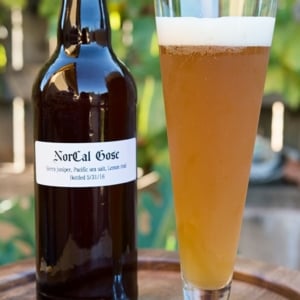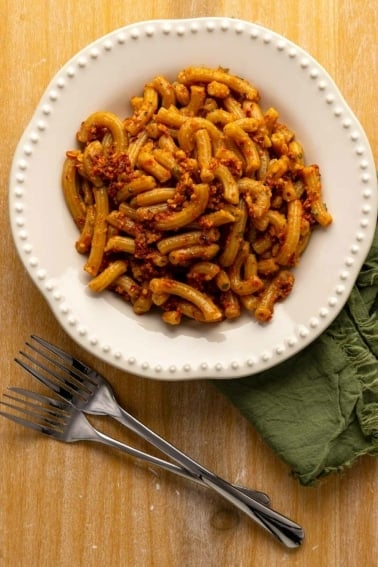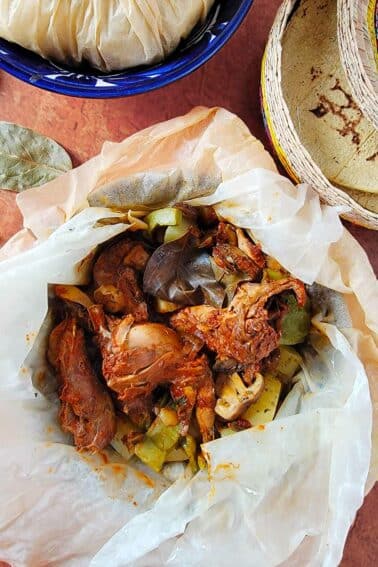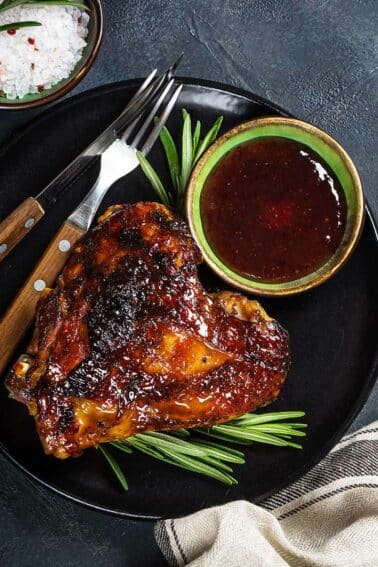As an Amazon Associate I earn from qualifying purchases.
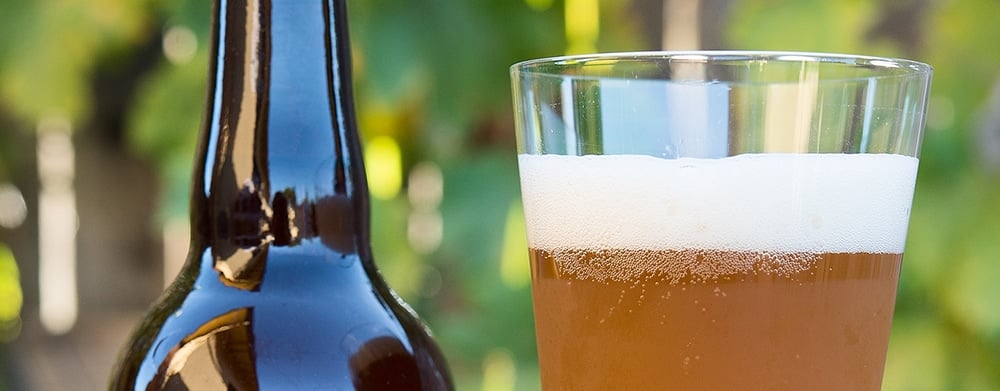
Chances are you have never heard of a gose beer. Pronounced go-zuh, this is an obscure style of beer from Leipzig, Germany that just happens to be one of the greatest summer guzzlers ever.
Why? Because it is essentially a natural michelada: Instead of adding lime to the beer and serving it in a salt-rimmed glass, this beer is naturally a little salty and tart.
How you get there is up to you. Some brewers use acidulated malt, which is barley malt allowed to sour a little. Some sour their malt themselves, and some just add some food grade lactic acid to the finished beer. The salt goes into the boiling wort (sugary malted water that will ferment to become beer), as do any other spices.
My gose beer recipe hinges on where I live, in Northern California: I use salt I made by boiling away Pacific seawater, lemon rind from my backyard tree, and juniper berries from the Sierra Nevada.
The beer should be pretty well carbonated, light-ish, but not so light as a pilsener, and should have some wheat in it, which gives the beer a little bit of a softer edge.
To make it, you need to be set up for brewing. If you are, you’re good to go. If you’re not, there is substantial equipment you really do need to do this right. At a minimum, you will need:
- A large pot, or several slightly smaller ones. I used a regular stockpot plus another soup pot before I got a proper brewing kettle.
- A thermometer. I highly recommend a laser thermometer. I use this one
.
- A gram scale. Yep, precision matters in beer making. This is the scale
I use.
- Something to ferment in. I prefer glass carboys, which are large jugs, but some people prefer buckets.
- An airlock. You need to keep air off the fermenting beer at the same time you let CO2 escape. The airlock does the trick.
- A strainer. A fine-meshed strainer removes debris, called trub, and the stray bits of seasoning and hops.
- Sanitizer. Yes, you need it. There are any number of good ones out there, but I use either Iodophor
or Star-San.
- Bottles, caps and a capper
, or a kegging system.
And, of course, you need malt and hops and yeast. Your nearest homebrew store will have all of this stuff, or you can buy it online. And for the beer, you might want to pick up some food grade lactic acid. In this recipe, you will get significant tartness from the acidulated malt, so taste the finished (albeit uncarbonated) beer before adding any lactic, OK?
This is not a hard beer to make, it is ready to drink in a month if you are using bottles, less if you are kegging, and it goes down real easy.
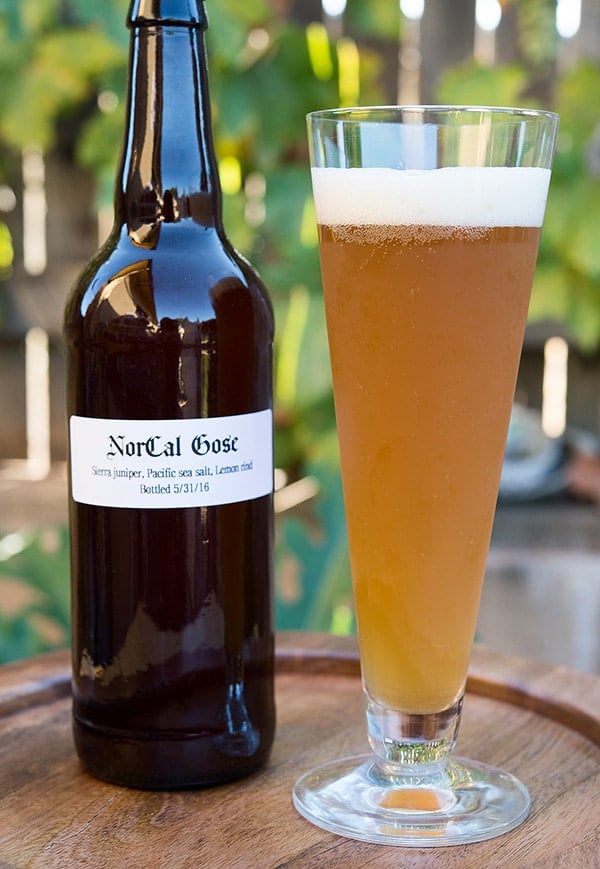
Here are the estimated stats on this recipe:
- Estimated Alcohol by Volume (ABV): 5.2%
- IBUs: 10
- SRM (a marker for color): 5, between golden and straw
- Original Gravity and Final Gravity: 1.055, going down to 1.015
NorCal Gose Beer
Ingredients
- 29 ounces dry wheat malt extract (54%)
- 12 ounces light dry malt extract (22%)
- 13 ounces acidulated malt, crushed (24%)
- 10 grams low alpha acid hops, like Saaz or Styrian Goldings (pellets)
- 20 grams juniper berries, crushed
- Peeled zest from 1 lemon
- 14 grams sea salt
- 1 Whirlfloc tablet (optional)
- White Labs German Ale/Kolsch WL029, at room temperature
- 2 to 3 teaspoons 88% lactic acid (optional)
Instructions
- Mash the acid malt. Put the acidulated malt into a grain bag or tie it up loosely in cheesecloth and cover it with 2 quarts of water. Bring this to 150°F to 155°F over medium heat and hold it at this temperature for 30 minutes. Remove the bag and set it over the pot in a strainer. Pour 2 quarts of water heated to 170°F over it to rinse the grain. Let the bag drain for 10 minutes, then remove. Discard the grain or feed it to animals.
- Start the boil. Add 3 more gallons of water to the pot and bring this to a boil. As the water heats up, stir in both extracts, making sure there are no lumps. When you reach a boil, add the hops and set the timer for 1 hour.
- Add the seasonings. With 10 minutes to go, add the juniper, salt and lemon rind, plus the Whirlfloc tablet if you are using it. If you have a wort chiller, now is the time to put it in the boiling wort so it can sanitize.
- Crash chill the wort. Use your wort chiller to chill the wort back to 75°F or cooler, depending on how warm your tap water is. Or, put the pot in a cooler with lots of ice water in it. Use a clean metal spoon to create a whirlpool in the wort, which will help it chill faster. Hopefully you will see gnarly bits in the wort that look like egg drop soup, or separating miso in soup: That's cold crash trub, and seeing it means you will have a clearer beer.
- Move the wort to the fermentor. Add the yeast to the fermentor; I use a glass carboy. Pour the contents of the pot through a sanitized strainer into the fermentor. If the strainer gets all gunked up with trub, remove it before continuing. Put a sanitized airlock on the fermentor and put the beer in a place where it can ferment cool, ideally 66°F to 69°F. Leave it there for 1 week.
- Rack the beer to a secondary. If there is a lot of gunk in the fermentor, rack the beer from the primary fermentor to a sanitized secondary fermentor -- this one needs to be a glass carboy. I do this only if there is a lot of crud in the fermentor. Either way, let the beer finish fermenting for 1 more week.
- Bottle or keg the beer. If you are bottling, you want to add enough priming sugar to the batch to get about 3.4 volumes of CO2. If you are using the lactic acid, add it to the beer with the priming sugar before bottling. Bottle condition 2 weeks before drinking.
Nutrition information is automatically calculated, so should only be used as an approximation.
